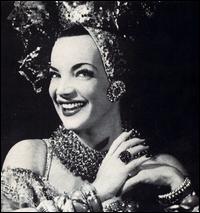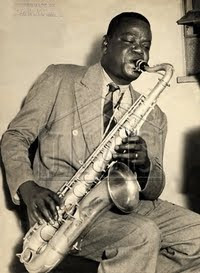The Lady With The Tutti Frutti Hat - Carmen Miranda
 A career profile from the All Brazilian Music website reeds:
A career profile from the All Brazilian Music website reeds:Carmen Miranda (1909 - 1955) still stands as the most successful female Brazilian singer outside of the country. Born in Portugal, she was brought to Brazil as a baby, settling in Rio with her family. At age 15, she was working at a hat shop. In 1928, Carmem met with composer and guitarist Josué de Barros, who invited her for a benefit presentation and later introduced her into the radio world. The first recording happened in 1929, through Brunswick, featuring the samba "Não Vá Simbora" on one side and the choro "Se o Samba É Moda" on the other, both written by Josué. Her first great hit, "Pra Você Gostar de Mim (Taí)", was a sales phenomenon with 36.000 copies sold. She proceeded to make a number of recordings, worked in the movies and, as a duo with her sister Aurora, made history at the legendary Cassino da Urca, where, in 1928, Carmem first wore the costume that would become her trademark around the world.
At Cassino da Urca, she met a north-American producer who convinced her to travel to the United States. Accompanied by the Bando da Lua, Brazil’s greatest star left countless fans crying at her departure, arriving in America in 1939 – a complete unknown who couldn’t say a word in English. Soon she was performing songs like "Mamãe Eu Quero", "Tico-tico no Fubá", "O Que É Que a Baiana Tem?" and "South American Way" to big audiences, becoming a phenomenon also in the States as the second best paid artist in Hollywood. She was in 10 Hollywood movies, being dubbed The Brazilian Bombshell.
In 1940 she returned briefly to Brazil, being acclaimed by most of her fans, but also ditched by the crowds at Cassino da Urca. Devastated, Carmen requested that a song be made about the situation, and recorded "Disseram que Voltei Americanizada" ("They Say I’ve Been Americanized"). After that, she went back to the States and settled in Beverly Hills, maintaining her career as a singer and film and TV actress. In 1954, the pressures of the entertainment and music industries gave her a nervous breakdown, and Miranda returned to Brazil for treatment and some rest. Back in Beverly Hills in 1955, she suffered a heart attack and died, in August, after almost fainting during a TV performance.
Enjoy Carmen Miranda as the lady with the tutti frutti hat singing "Tico-tico no fúba", click here
Further info on Carmen Miranda including soundclips at AMG
A website dedicated to Carmen Miranda available here
Jo



0 Comments:
Post a Comment
<< Home